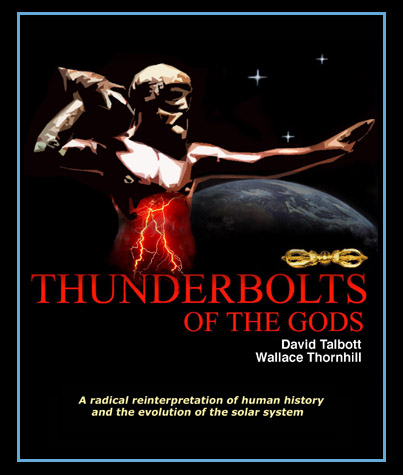
home •
about •
essential guide •
picture of the day •
thunderblogs •
news •
multimedia •
predictions •
products •
get involved •
contact

Credit: Halton Arp, Seeing Red, p. 241
pic of the day
archive
subject index
abstract
archive
Links:
Society for
Interdisciplinary
Studies

Thunderbolts of the Gods is a
108 page 8-1/2 x 11 full color monograph based on the life work of the two
authors--a revolutionary synthesis of comparative mythology and the
newly-discovered "Electric Universe".

The Monograph includes
an hour-long DVD introducing various aspects of the Electric
Universe explained by members of the Thunderbolts Group.
Nov 04, 2005
Bigger View of the Local Group
What can we "see" about the Local Group of galaxies now that "redshift- equals-distance" does not override observations? We can see that the Local Group stretches in a line along the minor axis of M31, the Andromeda galaxy, which is the dominant galaxy in the group
“The greatest mistake in my opinion, and the one we continually make, is to let the theory guide the model.... [S]cientists actually proceed on the belief that theories tell you what is true and what is not true! Of course that is absurd—observations and experiments describe objects that exist—they cannot be ‘right’ or ‘wrong.’ Theory is just a language that can be used to discuss and summarize relationships between observations. The model should be completely empirical and tell us what relationships between fundamental properties are required.”
Halton Arp, Seeing Red
Previously we “saw”—in radio and x-ray light—that the dots of galaxies in the Virgo and Fornax clusters are connected with swirls of highly excited material. Incorporated into these swirls are quasars, compact clusters and active galaxies.
But we didn’t need to look so far to see a relationship that’s right before our eyes. The Local Group, of which our Milky Way is a member, stretches in a line along the minor axis of M31, the Andromeda galaxy, which is the dominant galaxy in the group. In the image above, the filled circles mark the locations of accepted members. Open circles and plus signs mark the locations of higher-redshift dwarf and spiral galaxies respectively. (Although in other clusters similar dwarfs and spirals are accepted as companions of the larger galaxies, these dwarfs and spirals are excluded because their systematically higher redshifts are too obvious.) Redshifts of several objects are printed beside their names.
Long-exposure photographs of this area reveal a cloud of low-luminosity material extending along this line of galaxies and engulfing them. That the higher-redshift galaxies are not “background objects” is shown by their interaction with the cloud: The interacting pair of galaxies, NGC935/IC1801, have a semicircle of brighter material around them. NGC918 has a jet that ends in a bright region of the cloud.
The high-redshift radio galaxy, 3C120, is most famous for its “faster-than-light” jet. Astronomers have measured the movements of knots of material in the jet. If the galaxy is located where the redshift-equals-distance theory dictates, the knots would have to be traveling six times the speed of light. But if 3C120 is a member of the Local Group, the knots would be traveling at only four percent of the speed of light.
Not shown in the diagram are the line of quasars extending across M33 and the cluster of quasars close around 3C120. In addition, low surface brightness galaxies, with redshifts between .015 and .018, cluster around these two galaxies.
Until recently, we saw stars as points of light in a dark and empty sky. With the invention of radio and x-ray telescopes, we began to see that the sky is filled with swirls of light. In our Local Group, we can now see this pattern of connectedness in visible light. The darkness was in our eyes and the emptiness was in our imaginations.
The institutions and theories of a dark and empty astronomy served us well for their time. But now is the time to imagine a new astronomy that’s bright and entwined. Arp closes his discussion of the Local Group with this question: “Do astronomers really prefer to elaborate obsolete theoretical assumptions rather than make new discoveries?”
EXECUTIVE EDITORS:
David Talbott, Wallace Thornhill
MANAGING EDITOR:
Mel Acheson
CONTRIBUTING EDITORS: Michael Armstrong, Dwardu Cardona, Ev Cochrane,
C.J. Ransom, Don Scott, Rens van der Sluijs, Ian Tresman
WEBMASTER: Michael Armstrong
Copyright 2005: thunderbolts.info